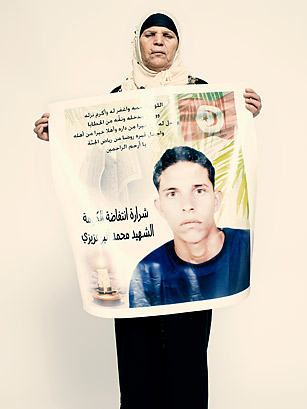
Mohamed Bouazizi's mother and siblings don't live in their hometown of Sidi Bouzid anymore. Their exceedingly humble, mottled-white home has been empty for months, abandoned behind a padlocked, pale gray metal door. Instant fame, it seems, has taken its toll on the family.
A year ago, the Bouazizis and their hardscrabble, dead-end town in central Tunisia were completely unknown. Mohamed, 26, a produce vendor who eked out a meager living selling his wares from a cart he pushed around all day along uneven, dusty streets, could have been anyone in any town in any country in the Middle East. That, in the end, was perhaps why he became such a powerful symbol.
The world now knows what happened to the scrawny young man on Dec. 17, 2010. How Bouazizi (whose real first name was Tarek) became enraged by his public humiliation at the hands of a policewoman who had harassed and threatened his livelihood one too many times. He tried to complain to local officials at the governorate, but they ignored him and refused him entry. Incensed, Bouazizi stood outside the sand-, peach- and cream-colored edifice on the main road, in the middle of traffic, and set himself, Tunisia and the rest of the Middle East on fire. Bouazizi lingered in the hospital until Jan. 4. Just 10 days after he died, Tunisian President Zine el Abidine Ben Ali's 23-year rule of Tunisia was over.
Bouazizi's act of desperation and defiance ricocheted across a region whose long-disenfranchised people were hungry for basic dignities and fed up with the calcified, corrupt and dictatorial regimes that lorded over them. His family and hometown were instantly thrust into the national, regional and eventually global spotlight.
But in the months since the crush of foreign and local media crews, dignitaries and well-wishers has subsided, a quiet backlash has developed against the Bouazizis in some parts of their impoverished town. "As the days went on, the talk increased, and the attempt to smear us started," says Bouazizi's mother Mannoubia, a field hand who was picking olives on the fateful morning of her son's self-immolation almost a year ago. "They started saying we have a lot of money now, that all the journalists paid us. They would knock on our gate, ask us for money, or call my children on their phones."
The family moved into the bottom floor of a two-story home in La Marsa, a picturesque coastal town and popular vacation spot near the capital, Tunis. But the Bouazizis don't live in the swanky part, with its pristine white double-story homes and their azure shutters, wide clean streets and manicured lawns. Their rented abode, while clearly a step up from the well-kept four-room home in Sidi Bouzid, is in a narrow alleyway across from a dusty soccer field whose fringes serve as a garbage landfill. "They say we live in a castle," Mannoubia says, gesturing around the small room she receives guests in.
Back in Sidi Bouzid, the black graffiti once spray-painted across a concrete wall at the end of the Bouazizis' narrow street, proudly proclaiming Mohamed as "the son of Hay al-Noor [his neighborhood] in Sidi Bouzid, this is the location of the revolution," has been crudely covered over. So has other graffiti across town, although handwritten cloth banners have recently appeared to mark Dec. 17, the date he set himself on fire. A giant canvas poster of Bouazizi that used to hang from the town's central monument, a copper-colored pillar dedicated to Sidi Bouzid's agricultural roots, has been removed.
"Some people were digusted because they felt Bouazizi's mother got money in exchange for her son's life," says Bushra Amrawi, 24, an accountant, who was sitting on the monument's circular steps with her mother Latifa, 48. "The people here are very poor," says Latifa, by way of explanation. "Maybe that's why."